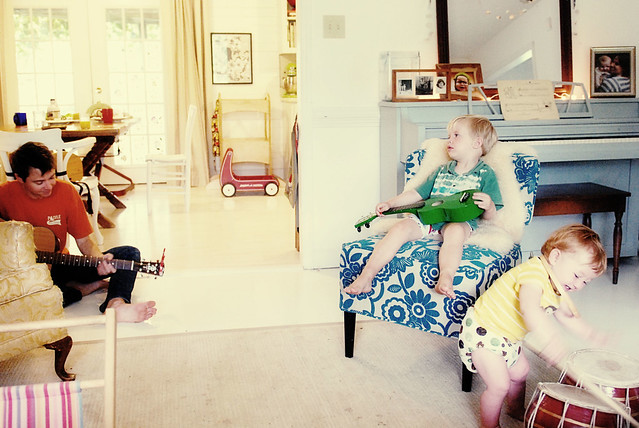You're in your toddler's music class. Your teacher is "inviting" you to sing. Ha! No way are you going to be humiliated in front of all these people! You resist. She'll never notice that you're not singing. Nobody else is singing, anyway. You'll look like a fool. But -- oh no! Your teacher, in the guise of trying to "engage" the class, is subtly looking at every single adult in the room, making eye contact and watching their mouths move to see if they're actually singing! Whatever. You've got this. You start mouthing the words to the song. You're here for your kid, after all. This class isn't for you. Your child needs to learn music, because it's supposed to help with her brain development or something. Your brain is already developed.
Then it happens. The teacher looks at you. Your eyes lock, and she gives you a knowing, laughing glance. She's seen through your ruse! She knows you're not singing! She is wordlessly communicating to you that if you don't start singing post-haste, you'll be called out in front of the entire class!
You are mortified. You start singing...a little. It's terrifying, but better than having that teacher keep giving you The Look. Then, slowly, you start to feel something inside you start to release. The noose that you didn't even realize you had around your heart is beginning to loosen. Images flash through your head. The choir teacher who told you to just mouth the words during the performance...the parent who told you to stop "screeching" in the shower...the smug DJ who laughed at you during karaoke night...one by one, their iron grips on your vocal cords crumble away, and you are singing! You are Taylor Swift! You are Adele! You are Lady Gaga! You are going to be a MILLIONAIRE!!!
Okay, maybe not. But you are singing, and because you are singing, that little part of your soul that had been locked away inside you is breaking free.
Singing is like running down a hill on a sunny day. It's like getting up on waterskis and feeling the wind rushing through your hair as you glide across the water. It's a release (literally -- it's an endorphin release. Just ask Cosmo). It's you getting to be totally, freely, completely you.
And here's the secret. It doesn't matter what you sound like. What matters is that you're doing it. And by setting that little piece of your soul free with song, you're teaching your child to do the same thing.
So, to summarize, here are the top five reasons to sing your heart out in your toddler's music class:
1. Your teacher won't call you out in front of the whole class for not singing.
2. You might become a millionaire. Beyonce had to start somewhere, right?
3. This is payback to all the people who ever told you not to sing.
4. You'll be setting your soul free and releasing endorphins.
5. You're empowering your child to find her voice and send that little bit of her soul out into the world.
"Miss" Lindsay is the Director of Kindermusik with Miss Lindsay & Friends. For more information on our holistic approach to teaching music to babies, toddlers, and preschoolers, please visit www.eastbaykindermusik.com.














